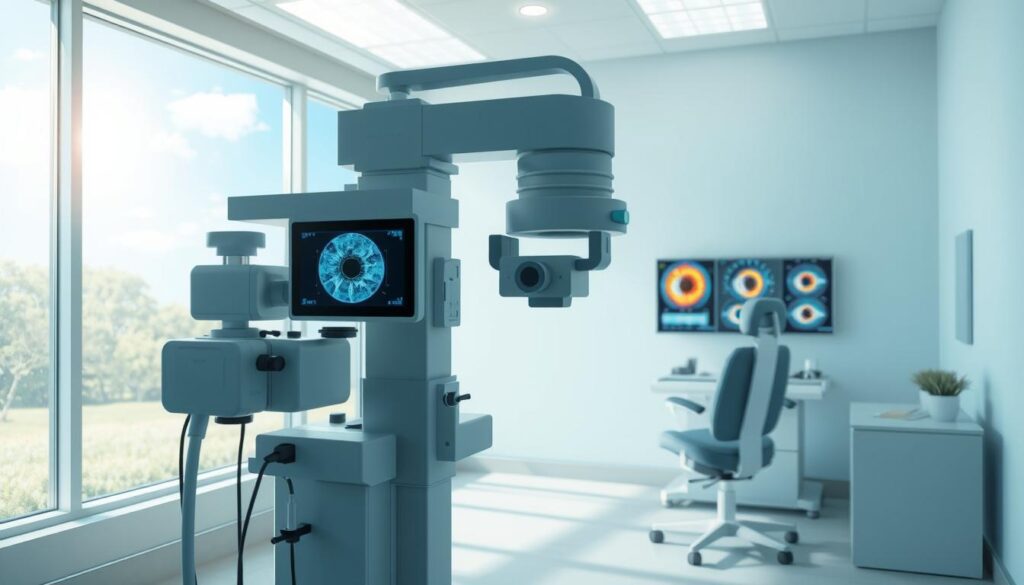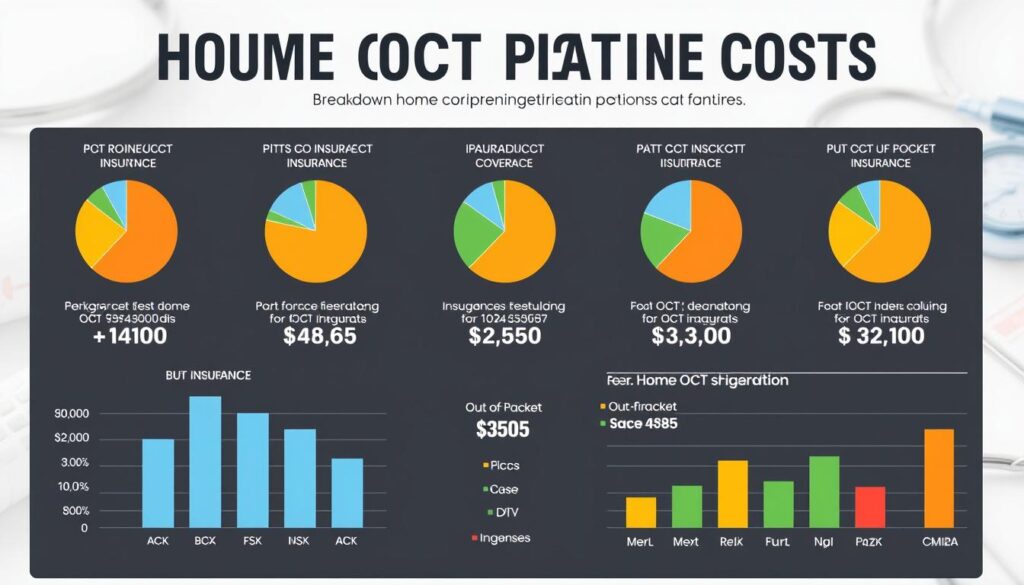As we get older, our eyes can face many complex issues. Conditions like age-related macular degeneration, diabetic retinopathy, and glaucoma need regular checks. The Scanly Home OCT technology is a game-changer, letting patients check their eye health at home. But, it raises questions about insurance coverage and costs.

This guide will help you understand Scanly Home OCT insurance coverage. We’ll look at what affects costs and how to get the most from your insurance. Whether you’re dealing with Medicare, private insurance, or need financial help, this article will guide you. It’s your key to managing the costs of this innovative technology.
Key Takeaways
- Scanly Home OCT is a revolutionary technology that allows for remote monitoring of eye health, reducing the need for frequent clinic visits.
- Insurance coverage for Scanly Home OCT varies, with factors like medical necessity, insurance type, and patient condition impacting the level of coverage and out-of-pocket expenses.
- Medicare Part B may cover OCT imaging if deemed medically necessary, but typically does not cover home-use devices.
- Private insurance plans have varying policies regarding vision care coverage, and understanding these nuances is crucial for maximizing benefits.
- Exploring financial assistance programs and cost-saving strategies can help reduce the burden of Scanly Home OCT patient costs.
Understanding Scanly Home OCT Technology and Its Benefits
The Scanly Home OCT device is a game-changer for eye health. It brings advanced optical coherence tomography (OCT) imaging to your home. This technology captures detailed images of your retina, offering insights into your eye health.
How OCT Technology Works for Home Monitoring
The Scanly Home OCT device scans each eye in under a minute. It captures a 10×10-degree area around the fixation point. The images then go to the Notal Health Cloud for analysis.
There, the AI-based Notal OCT Analyzer (NOA) looks at the images. It finds and measures the volume of hypo-reflective spaces. This is key for managing neovascular age-related macular degeneration (nAMD), diabetic retinopathy, and glaucoma.
Key Features of Scanly Home Device
- Wireless connectivity for easy data transmission
- AI-powered analysis of retinal images
- User-friendly interface for seamless self-imaging
Benefits of Remote Eye Health Monitoring
The Scanly Home OCT device has many benefits. It allows for remote retinal imaging. This can lead to early detection of eye changes.
It also means fewer in-office visits. This can improve treatment outcomes for nAMD, diabetic retinopathy, and glaucoma.
“Home monitoring for neovascular age-related macular degeneration (AMD) suggested a potential annual savings of $3,200 per patient.”
Studies show home OCT technology could save up to $3.5 billion a year in the U.S. It optimizes treatment and cuts down on lost productivity from office visits.
Insurance Coverage Options for Home OCT Devices
Insurance for home OCT devices like the Scanly Home OCT can change a lot. Some plans might cover part or all of the cost, especially for people with serious eye problems like AMD.
Some plans cover the device’s cost and the fees for ongoing checks. Durable medical equipment (DME) insurance often pays for the device if an eye doctor prescribes it. Medicare Part B might cover OCT imaging services if they’re needed, but it doesn’t cover home devices.
Private insurance plans vary in what they cover for vision care. It’s important to ask your insurance about the Scanly Home OCT. Some plans might include OCT screenings as part of their vision insurance.
Cost Savings and Financial Assistance
Using the Scanly device at home can save AMD patients a lot of money. It can save between $15,000 and $20,000 over five years compared to going to the doctor’s office. This is because it cuts down on office visits by 30% and emergency treatments by 20-30%, saving on out-of-pocket expenses.
Notal Vision, the maker of the Scanly Home OCT, shares information on costs covered by DME insurance and subscription fees. Patients should look into these resources to understand their costs and find preventive eye care coverage.
“The Scanly Home OCT device can significantly reduce the burden of frequent office visits and provide earlier detection of vision-threatening conditions, ultimately leading to better outcomes and cost savings for patients.”
– Dr. Jane Hahn, Ophthalmologist
Medicare and Private Insurance Reimbursement Guidelines
It’s important for patients to know how insurance covers home OCT devices. Medicare and private insurers have their own rules for these new technologies.
Medicare Coverage Requirements
Medicare Part B covers home OCT devices like Scanly Home OCT. But, there are certain rules to follow. Patients need to show that these devices are medically necessary, especially for conditions like age-related macular degeneration (AMD).
Doctors and monitoring centers can use specific CPT codes (0604T, 0605T, 0606T) to bill for these services every 30 days.
Private Insurance Policy Variations
Private insurance plans differ a lot in what they cover for vision care, including home OCT devices. Some insurers have added these new monitoring tools to their coverage. But, others haven’t updated their policies yet.
Patients should check their plans carefully. This way, they’ll know what’s covered and what’s not.
Documentation Needed for Claims
Having the right documents is key for getting insurance claims approved. Patients should work with their doctors to make sure their medical records are up to date. These records should show why regular OCT scans are needed.
Also, patients might need to fight for coverage or look into patient assistance programs if claims are denied.
By understanding the rules and what’s needed for claims, patients can better use home OCT technology. This way, they can get the care they need.

Scanly Home OCT Patient Cost Insurance: A Complete Breakdown
Understanding the costs and insurance for Scanly Home OCT can be tough. But knowing the details helps patients make smart choices about their eye health. The Scanly Home OCT costs between $500 and $1,000, with most of this covered by insurance.
Patients also need to think about monthly fees for monitoring, which are $50 to $150. How much insurance covers these fees varies, so it’s key to check your policy.
| Cost Component | Range | Insurance Coverage |
|---|---|---|
| Scanly Home OCT Device | $500 – $1,000 | Majority covered by insurance |
| Monthly Monitoring Subscription | $50 – $150 | Varies by insurance plan |
What patients pay out-of-pocket depends on their insurance. But, home OCT monitoring costs less than in-office. It can save $15,000 to $20,000 over five years.
By looking at costs and insurance, patients can choose the best eye health monitoring. This fits their needs and budget.

Preventive Care Coverage and Cost-Saving Strategies
Preventive eye care coverage can greatly lower the cost of Scanly Home OCT monitoring. It’s important for patients to check their insurance plans for such benefits. This can help cover some of the costs of home OCT devices. Also, some healthcare providers offer financial help to low-income patients, which is a big help.
Qualifying for Preventive Care Benefits
To get preventive care benefits, patients need to talk to their insurance and healthcare teams. They will explain what’s needed to qualify. This might include age, risk factors, or how often you need eye exams and screenings.
Available Financial Assistance Programs
For those without enough insurance or facing high costs for Scanly Home OCT, there are financial help programs. These include patient assistance from the Notal Vision Monitoring Center and other groups. They work to make eye care more affordable for everyone.
Tips for Reducing Out-of-Pocket Expenses
To cut down on costs, patients can shop around for providers, talk about payment plans, and look for discounts. The Notal Vision Monitoring Center can help with insurance billing too. Using these tips, patients can enjoy the benefits of Scanly Home OCT monitoring without breaking the bank.
You Should Check This As Well
pet insurance covers organ transplant
FAQ
What is Scanly Home OCT and how does it work?
Scanly Home OCT is a device that uses light waves to take detailed pictures of the retina. It helps spot eye diseases early, like age-related macular degeneration and diabetic retinopathy. This way, patients can check their eye health at home, cutting down on clinic visits.
What are the key features of the Scanly Home OCT device?
The Scanly Home OCT has wireless connectivity and uses AI for analysis. It’s easy to use and captures images in a 10×10-degree area. The scans are quick, taking less than a minute per eye. The images then go to the Notal Health Cloud for AI analysis.
What are the benefits of using Scanly Home OCT for remote eye health monitoring?
Using Scanly Home OCT helps spot retinal changes early. It means fewer trips to the doctor and better eye health over time. It’s great for monitoring eye diseases from home.
How does insurance coverage work for Scanly Home OCT?
Insurance for Scanly Home OCT varies a lot. Some plans might cover all or part of the cost, especially for serious conditions. It’s important to check what your plan covers, including the device and ongoing fees.
What are the Medicare and private insurance reimbursement guidelines for Scanly Home OCT?
Medicare might cover OCT imaging if it’s needed for managing conditions like AMD. But, it usually doesn’t cover devices for home use. Private insurance policies vary a lot, so it’s best to check what your plan covers.
How much does Scanly Home OCT cost for patients, and how can they save on out-of-pocket expenses?
The cost of Scanly Home OCT includes the device and monthly fees for monitoring. The total cost depends on your insurance. To save, check if your insurance covers preventive eye care, look for financial help, and talk about payment plans.
How can patients maximize their insurance benefits for Scanly Home OCT?
To get the most from your insurance, understand what’s covered and what you need to document. Use patient advocacy services if claims are denied. Also, check if your plan covers preventive eye care and look for financial help.







